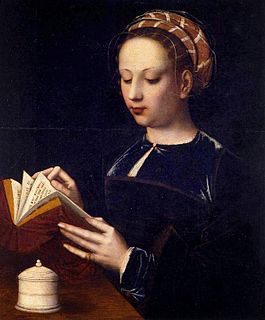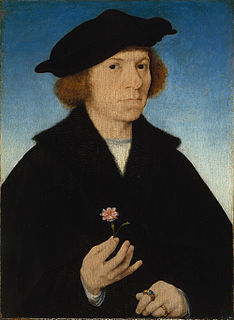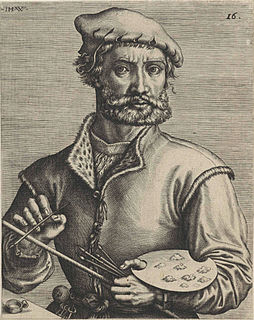 W
WAmbrosius Benson was an Italian painter who became a part of the Northern Renaissance.
 W
WIzaak van den Blocke or Isaak van den Blocke (1574–1626) was a painter of Flemish descent who spent his active career in Poland. He is known for his decorative paintings in various official buildings and residences in Gdańsk. He also completed commissions for churches and painted facades. He was in 1612 one of the founders of the painters' guild of Gdańsk.
 W
WHans Bol or Jan Bol, was a Flemish painter, print artist, miniaturist painter and draftsman. He is known for his landscapes, allegorical and biblical scenes, and genre paintings executed in a late Northern Mannerist style.
 W
WHendrick van den Broeck or Arrigo Fiammingo was a Flemish painter, fresco painter, glass painter and sculptor of the late-Renaissance or Mannerist period. After training in Flanders, he travelled to Italy where he remained active in various cities for the remainder of his life. He was court painter to Cosimo I de Medici in Florence and worked as a fresco painter in Rome on the large decorative projects of pope Gregory XIII.
 W
WPieter Bruegel the Elder was the most significant artist of Dutch and Flemish Renaissance painting, a painter and printmaker, known for his landscapes and peasant scenes ; he was a pioneer in making both types of subject the focus in large paintings.
 W
WDenis Calvaert was an Antwerp-born Flemish painter, who lived in Italy for most of his life, where he was known as Dionisio Fiammingo or simply Il Fiammingo. Calvaert was a profound student of architecture, anatomy, and history, his works are characterized by their advanced composition and colouring.
 W
WPeter de Witte, known in Italy as Pietro Candido and in Bavaria as Peter Candid was a Flemish-born Mannerist painter, tapestry designer and draughtsman active in Italy and Bavaria. He was an artist at the Medici court in Florence and at the Bavarian court of Duke William V and his successor Maximilian I in Munich.
 W
WHendrick de Clerck was a Flemish painter active in Brussels during the late sixteenth and early seventeenth centuries. Stylistically he belongs to the late Mannerist generation of artists preceding Peter Paul Rubens and the Flemish Baroque, and his paintings are very similar to his contemporary Marten de Vos. His exact date of birth is unknown, but in 1594 he is employed as court painter to Archduke Ernest, a position he continued to hold in the service of the Archdukes Albert and Isabella following Ernest's death in 1596.
 W
WJoos van Cleve was a painter active in Antwerp around 1511 to 1540. He is known for combining traditional Dutch painting techniques with influences of more contemporary Renaissance painting styles.
 W
WPieter Coecke van Aelst or Pieter Coecke van Aelst the Elder was a Flemish painter, sculptor, architect, author and designer of woodcuts, goldsmith's work, stained glass and tapestries. His principal subjects were Christian religious themes. He worked in Antwerp and Brussels and was appointed court painter to Charles V, Holy Roman Emperor.
 W
WGillis van Coninxloo was a Flemish painter of landscapes who played an important role in the development of Northern landscape art at the turn of the 17th century. He spent the last 20 years of his life abroad, first in Germany and later in the Dutch Republic.
 W
WJacob de Backer was a Flemish Mannerist painter and draughtsman active in Antwerp between about 1571 and 1585. Even though he died young at the age of 30, the artist was very prolific and an extensive body of work has been attributed to him. Art historians are not agreed on how many of these works are autograph or the product of a workshop. The works attributed to the artist or his workshop are executed in a late-Mannerist style clearly influenced by Italian models.
 W
WAmbroise Dubois (1542/43–1614/15) was a Flemish-born French painter.
 W
WHans Eworth was a Flemish painter active in England in the mid-16th century. Along with other exiled Flemings, he made a career in Tudor London, painting allegorical images as well as portraits of the gentry and nobility. About 40 paintings are now attributed to Eworth, among them portraits of Mary I and Elizabeth I. Eworth also executed decorative commissions for Elizabeth's Office of the Revels in the early 1570s.
 W
WFrans Floris, Frans Floris the Elder or Frans Floris de Vriendt was a Flemish painter, draughtsman, print artist and tapestry designer. He is mainly known for his history paintings, allegorical scenes and portraits. He played an important role in the movement in Northern Renaissance painting referred to as Romanism. The Romanists had typically travelled to Italy to study the works of leading Italian High Renaissance artists such as Michelangelo, Raphael and their followers. Their art assimilated these Italian influences into the Northern painting tradition.
 W
WJan Sanders van Hemessen was a leading Flemish Renaissance painter, belonging to the group of Italianizing Flemish painters called the Romanists, who were influenced by Italian Renaissance painting. Van Hemessen had visited Italy during the 1520s, and also Fontainebleau near Paris in the mid 1530s, where he was able to view the work of the colony of Italian artists known as the First School of Fontainebleau, who were working on the decorations for the Palace of Fontainebleau. Van Hemessen's works show his ability to interpret the Italian models into a new Flemish visual vocabulary.
 W
WJoris Hoefnagel or Georg Hoefnagel was a Flemish painter, printmaker, miniaturist, draftsman and merchant. He is noted for his illustrations of natural history subjects, topographical views, illuminations and mythological works. He was one of the last manuscript illuminators and made a major contribution to the development of topographical drawing.
 W
WKarel van Mander (I) or Carel van Mander I was a Flemish painter, poet, art historian and art theoretician, who established himself in the Dutch Republic in the latter part of his life. He is mainly remembered as a biographer of Early Netherlandish painters and Northern Renaissance artists in his Schilder-boeck. As an artist and art theoretician he played a significant role in the spread and development of Northern Mannerism in the Dutch Republic.
 W
WJan Massijs or Jan Matsys was a Flemish Renaissance painter known for his history paintings, genre scenes and landscapes. He also gained a reputation as a painter of the female nude, which he painted with a sensuality reminiscent of the school of Fontainebleau.
 W
WJoos de Momper the Younger or Joost de Momper the Younger was a Flemish landscape painter active in Antwerp between the late 16th century and the early 17th century. Brueghel's influence is clearly evident in many of de Momper's paintings. His work is situated at the transition from late 16th-century Mannerism to the greater realism in landscape painting that developed in the early 17th century. He achieved considerable success during his lifetime.
 W
WAdam van Noort was a Flemish painter and draughtsman and one of the teachers of Peter Paul Rubens, and the only teacher of Jacob Jordaens. Adam van Noort was mainly known for his history paintings but he also created some portraits. He was a designer for engravings for the Collaert family of printmakers and publishers.
 W
WWilliam Scrots was a painter of the Tudor court and an exponent of the Mannerist style of painting in the Netherlands.
 W
WBartholomeus Spranger or Bartholomaeus Spranger was a Flemish painter, draughtsman, sculptor and designer of prints. Working in Prague as a court artist for the Holy Roman emperor Rudolf II, he responded to his patron's aesthetic preferences by developing a version of the extreme style, full of conceits, which has become known as Northern Mannerism. This style stressed sensuality, which was expressed in smoothly modeled, elongated figures arranged in elegant poses, often including a nude woman seen from behind. Spranger's unique style combining elements of Netherlandish painting and Italian influences, in particular the Roman Mannerists, had an important influence on other artists in Prague and beyond as his paintings were disseminated widely through prints.
 W
WStradanus, Johannes Stradanus, Jan van der Straet or Giovanni Stradano was a Flemish artist active mainly in 16th-century Florence, Italy. He was a wide-ranging talent who worked as an easel and fresco painter, designer of tapestries, draughtsman, designer of prints and pottery decorator. His subject range was varied and included history subjects, mythological scenes, allegories, landscapes, genre scenes, portraits, architectural scenes and animals. After training in his native Flanders, he left his home country and ultimately settled down in Florence, Italy. He became a prominent court artist to the Medici during the second half of the 16th century and worked on the many decorative projects of the court. Stradanus also produced large altarpieces for the most important churches in Florence.
 W
WOtto van Veen, also known by his Latinized name Otto Venius or Octavius Vaenius, was a painter, draughtsman, and humanist active primarily in Antwerp and Brussels in the late 16th and early 17th centuries. He is known for running a large studio in Antwerp, producing several emblem books, and for being, from 1594 or 1595 until 1598, Peter Paul Rubens' teacher. His role as a classically educated humanist artist, reflected in the Latin name by which he is often known, Octavius Vaenius, was influential on the young Rubens, who would take on that role himself.
 W
WMaerten de Vos, Maerten de Vos the Elder or Marten de Vos was a Flemish painter. He is known mainly for his history and allegorical paintings and portraits. He was, together with the brothers Ambrosius Francken I and Frans Francken I, one of the leading history painters in the Spanish Netherlands after Frans Floris career slumped in the second half of the sixteenth century as a result of the Iconoclastic fury of the Beeldenstorm.